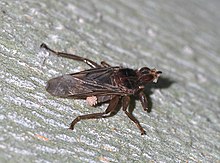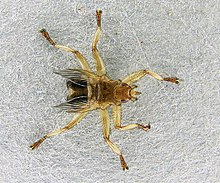Louse flies
| Hippoboscidae | ||||||||||||
|---|---|---|---|---|---|---|---|---|---|---|---|---|

Louse fly |
||||||||||||
| Systematics | ||||||||||||
|
||||||||||||
| Scientific name | ||||||||||||
| Hippoboscidae | ||||||||||||
| Samouelle , 1819 |
Louse flies (Hippoboscidae) represent a family of the two-winged (Diptera). Within this they are assigned to the flies (Brachycera).
features
The louse flies are small, extremely flat, brown and mostly flattened external parasites that suck blood in mammals and birds . There are both winged and wingless species, with louse flies like all flies only having one pair of wings. The horse fly ( Hippobosca equina ) has normal, long wings . The the crataerina pallida ( Crataerhina pallida ) are against downsized stub shaped. The sheep louse fly ( Melophagus ovinus ) has no wings at all. Some species also shed their wings after reaching the host, such as the deer louse fly ( Lipoptena cervi ). The hind wings, which have been transformed into swinging arches (holders), can be found in almost all species, with the exception of the sheep louse fly. The design of the eyes is consistent with that of the wings. Long-winged species have large eyes, wingless species only slightly developed eyes.
Way of life
Louse flies are ectoparasitic on mammals and birds. They hold onto the hair or plumage of their hosts with their strong claws . In the case of species with wings, the host is found optically, in the case of wingless species through physical contact between two host animals, e.g. between prey and raptor or individuals in a herd. The host specificity is very different. It is particularly pronounced in flightless mammalian parasites and very low in flightable bird parasites. People are approached by many species, but mostly leave again quickly.
Reproduction and development
The mating of the louse flies usually takes place on the host, whereby it is sometimes associated with pronounced flight games, as for example with the horse flies.
Viviparia is an essential characteristic of louse flies . The females give birth to live young animals, in this case larvae that are mature enough to pupate . In some of today's outdated taxonomies, this group of insects (including some related families that show the same behavior) was therefore referred to as pupipara, since the females give birth to young (only one at a time) as larvae in the late stages (so-called prepupariums). For the species Pseudolynchia canariensis and other louse flies, reproduction is incredibly energy-consuming. The larvae feed on the “mammary glands” of the female fly before they are born. Individual offspring (pupae) can weigh more than a poorly nourished adult fly, as the pupal shell is included in the pupal weight and the flies often increase in mass significantly after the first blood meal after molting.
The species of the northern regions including Central Europe usually form only one generation per year. The larvae and pupae usually live on the ground, in the case of the sheep louse fly also in the host's fur.
Systematics


In the past, the Hippoboscidae as louse flies in the actual sense were combined with the Streblidae and bat flies (Nycteribiidae) to form the louse flies in the broader sense (pupipara). All three groups give birth to larvae that pupate immediately after birth. This is also the case with the tsetse flies , with which they are usually grouped together to form the superfamily Hippoboscoidea today.
A total of about 100 species of these animals are known, 30 species are also common in Europe.
- Crataerina acutipennis Austen , 1926
- Crataerina melbae ( Rondani , 1879)
- Crataerina obtusipennis Austen , 1926
- Crataerina pallida ( Olivier in Latreille , 1811) - Common swift louse
- Hippobosca equina Linnaeus , 1758 - Horse fly
- Hippobosca longipennis Fabricius , 1805
- Hippobosca variegata Megerle , 1803
- Icosta ardeae ( Macquart , 1835)
- Icosta massonati ( Falcoz , 1926)
- Icosta minor ( Bigot in Thomson , 1858)
- Lipoptena arianae Maa , 1969
- Lipoptena capreoli Rondani , 1878
- Lipoptena cervi ( Linnaeus , 1758) - deer louse fly
- Lipoptena couturieri Séguy , 1935
- Lipoptena fortisetosa Maa , 1965
- Melophagus ovinus ( Linnaeus , 1758) - sheep louse , "sheep louse"
- Melophagus rupicaprinus Rondani , 1879
- Olfersia fumipennis ( Sahlberg , 1886)
- Olfersia spinifera ( Leach , 1817)
- Ornithoica turdi ( Olivier in Latreille , 1811)
- Ornithomya avicularia ( Linnaeus , 1758)
- Ornithomya biloba Dufour , 1827
- Ornithomya chloropus Bergroth , 1901
- Ornithomya fringillina Curtis , 1836
- Ornithomya rupes Hutson , 1981
- Ornithophila gestroi ( Rondani , 1878)
- Ornithophila metallica ( Schiner , 1864)
- Pseudolynchia canariensis ( Macquart in Webb & Berthelot , 1839) - pigeon louse fly
- Pseudolynchia garzettae ( Rondani , 1879)
- Stenepteryx hirundinis ( Linnaeus , 1758)
swell
Individual evidence
- ↑ ZADBI: Zurqui All-Diptera Biodiversity Inventory: How to Identify Flies - Cyclorrhapha , on: phorid.net, 2013. See: Hippoboscidae (louse flies), Natural History
- ↑ Joel Kits: Species Pseudolynchia canariensis - Pigeon Fly: Life Cycle , on: BugGuide, March 21, 2005; quoted under: Pigeon Louse Fly, we believe , on: What's That Bug
- ↑ Meredith Swett Walker: Behold the Hippoboscidae: Bizarre Biting Flies that Give Live Birth! ( en-US ) May 18, 2015. Retrieved February 10, 2019.
- ↑ Jessica L. Waite, Autumn R. Henry, Frederick R. Adler, Dale H. Clayton: Sex-specific effects of an avian malaria parasite on an insect vector: support for the resource limitation hypothesis . In: Ecology . 93, No. 11, 2012, ISSN 1939-9170 , pp. 2448-2455. doi : 10.1890 / 11-2229.1 .
- ↑ Hippoboscidae. Fauna Europaea, Version 1.3, April 19, 2007 , accessed on June 9, 2008 .
literature
- Joachim Haupt, Hiroko Haupt: Flies and Mosquitoes. Observation, way of life. Natur-Verlag, Augsburg 2001, ISBN 3-89440-278-4 .
- Werner Jacobs, Maximilian Renner: Biology and ecology of insects. Gustav Fischer Verlag, Stuttgart 1988, ISBN 3-437-20352-5 , p. 300f (Hippoboscidae).
- Klaus Honomichl, Heiko Bellmann : Biology and ecology of insects. (1 CD-ROM), Fischer, Stuttgart 1996, ISBN 3-437-25020-5 (book edition: Fischer, Stuttgart 1998, ISBN 3-437-25890-7 ).
Web links
- http://www.faunoekjmueller-magdeburg.de/Lausfliegen/lausfliegen.html Determination of louse flies
